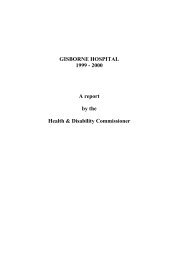09HDC01565 - Health and Disability Commissioner
09HDC01565 - Health and Disability Commissioner
09HDC01565 - Health and Disability Commissioner
You also want an ePaper? Increase the reach of your titles
YUMPU automatically turns print PDFs into web optimized ePapers that Google loves.
<strong>Health</strong> <strong>and</strong> <strong>Disability</strong> <strong>Commissioner</strong><br />
He states that this care does not need to be in the ICU, but the ward area/SCU<br />
needs to be properly equipped.<br />
Further information from Dr H<br />
Anaesthetist Dr H informed the Coroner that he reviewed his management of Mr A‘s<br />
care with a senior neuroanaesthetist <strong>and</strong> with the Director of the Acute Pain<br />
Management Service, <strong>and</strong> presented his management for peer review at the<br />
Department of Anaesthesia Mortality <strong>and</strong> Morbidity Review. Dr H contacted<br />
colleagues in Sydney <strong>and</strong> London to establish whether they were aware of<br />
unexplained deaths following surgery for Chiari 1 malformations (they were not). He<br />
also conducted a literature review <strong>and</strong> sought information from the American Society<br />
of Anaesthesiologists (ASA) Closed Claims Project. The ASA states: ―A search of the<br />
ASA Closed Claims Project database has no similar cases of Arnold Chiari<br />
Malformation <strong>and</strong> postoperative respiratory arrest yielded two claims in which<br />
patients with this condition sustained postoperative respiratory arrest. Neither patient<br />
was undergoing surgical correction of their malformation when the event occurred.<br />
Both events occurred in the early 1990s.‖<br />
Dr H provided the Coroner with details of further action he has taken in light of Mr<br />
A‘s death. This includes confirming that appropriate education strategies are available<br />
for the ward‘s nursing staff, <strong>and</strong> offering to take an education session on the ward<br />
with a particular focus on PCA devices. He states he has reiterated that:<br />
in addition to sedation scores, monitoring of respiratory rate is important where<br />
PCAs are used, <strong>and</strong> particularly for neurosurgical patients; <strong>and</strong><br />
that the clinical monitoring of patients by nursing staff is the lynchpin of patient<br />
safety in the clinical environment.<br />
5 September 2012 68<br />
Names have been removed (except Canterbury DHB <strong>and</strong> the experts who advised on this case) to<br />
protect privacy. Identifying letters are assigned in alphabetical order <strong>and</strong> bear no relationship to the<br />
person’s actual name.
















